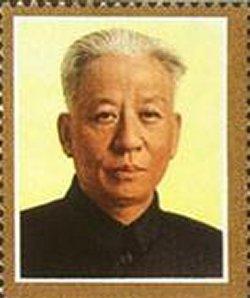
|
Communist Military Leaders of the Korean War
4. Head of State Liu Shaoqi Background and History Liu Shaoqi came from the same region and more or less the same social background as Mao Zedong. Liu was born in Hunan Province in 1898, the youngest son of a rich peasant landowner. Although Mao was also the son of a moderately well-to-do landowner there seemed to be a definite class difference between Liu and Mao in terms of demeanor and style. Liu seemed to be from a wealthier class than Mao. Liu attended middle school in Changsha, the capital of Hunan, but he journeyed to North China to study French. In 1920 he joined a socialist youth group and subsequently went to Moscow for further study. In Moscow he joined the Chinese Communist Party. After he returned to China, his reputation as a labor organizer grew. He rose rapidly in the party hierarchy, was a member of the central committee in 1927, and in 1934 was promoted to the powerful politburo. On to Page 5 Back to Page 3 |
|
| President Liu Shaoqi | ||
|
Liu became the Communists' foremost expert on organization and party structure. In the 1950s and early 60s he played an important role in all aspects of public life, especially as chairman and head of state of the Chinese People's Republic. Liu was an energetic man, very disciplined, conscientious, a good speaker but quiet in his private life. In 1922 Liu returned to China and became active in labor organizing for the Communist Party. He served for period as an aide to Mao. As well as organizing strikes Liu was also active in Communist Party organizational structure, receiving appointments a number of positions in the Party hierarchy. This was the period of cooperation between the Goumindang (Nationalist Party) and the Communist Party. The cooperation ended abruptly in April of 1927 when Chiang Kai-shek struck against the Party, attempting to exterminate the Communist Party. Liu survived and moved up further in the Party hierarchy. After assignments in Manchuria and elsewhere he moved to Shanghai, where Party activity continue despite Goumindang persecution. The persecution of the Communist Party in Shanghai and other cities finally drove the Party to the rural soviets such as the one organized by Mao in Jiangxi Province. In 1934 Liu was made a member of the Politburo for the Jiangxi Soviet. Soon afterwards the Party decided to evacuate the area in what became known as the Long March. Liu did not join the Long March but instead journeyed to Beijing to carry on Party activities for North China. In 1939 Liu joined the survivors of the Long March in Yenan. Attacked during the early stages of the Cultural Revolution as the "number one capitalist-roader," Liu was stripped of power in 1968 and murdered. He was rehabilitated posthumously in 1980. Back to Chinese Government Leader Choices |
||